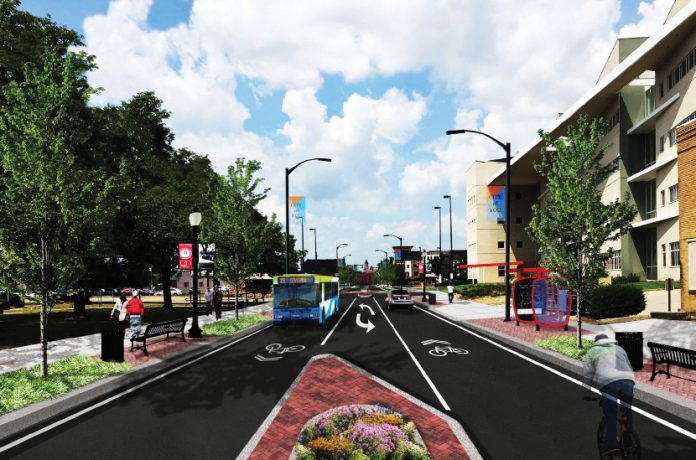
Since the formal adoption of the Youngstown 2010 Comprehensive Plan in 2005, the city has worked to downsize infrastructure and improve connections between the downtown and major stakeholders in the community. In 2009, the city collaborated with YSU by connecting the central business district to the university by extending Hazel Street north to Lincoln Avenue.
It’s in this spirit that Eastgate Regional Council of Governments, Mahoning Valley’s metropolitan planning agency, submitted an application in July to the U.S. Department of Transportation’s BUILD (Better Utilizing Investments to Leverage Development) program.
Eastgate hopes to obtain $10.8 million in federal funding for the Youngstown Smart2 Network, which aims to connect “Strategic & Sustainable, Medical & Manufacturing, Academic & Arts, Residential & Recreational, Technology & Training” centers in and around downtown.
If successful, the project would also leverage over $10.5 million in local matching funds. Eastgate offered to sponsor the application because of its potential to impact not only the city but also surrounding areas, said Jim Kinnick, Eastgate’s executive director.
“When you talk about the recreation, the technology, the medical aspect and the educational aspect – we have it all here,” Kinnick said. “However, it’s not easy to get to. It’s not well connected. This type of project will bring all these amenities together.”
Planned enhancements include improving pedestrian walkways and adding bicycle lanes, while subjecting several arteries to “road diets” (roadway-width reductions).
Fifth Avenue is the “spine” of the project, according to Kinnick. “One of the criteria for these types of grants is safety. When pedestrians are trying to cross several lanes of a road that’s not well lit, that’s dangerous.”
Fifth Avenue helps connects St. Elizabeth Hospital on Belmont, YSU and the WRTA Federal Station to the central business district, but is currently too wide and not friendly enough to pedestrians and bicyclists, he explained.
Fifth Avenue would be converted to a divided boulevard with a median, one lane on each side, a turning lane and multiuse lanes for bicyclists. “This is the ‘complete streets’ method of upgrading roads, Kinnick said. “We bring in the highway lighting, we make it pedestrian friendly, we build out the crosswalks, and we put the benches down. We’re going to have transit hubs for the shuttles.”
Rayen Avenue would be reduced from four lanes to three, and similar changes would be made to Front and Commerce streets as well as Park Avenue. According to the plan, an estimated total of 3.3 miles of road would be converted to bike lanes.
These changes are in stark contrast to the policies of the postwar urban renewal era, when approximately 104,000 more people lived in Youngstown. Planners predicted continuous growth for the city during the 1950s and beyond. At the time, motor vehicle registration rates were increasing at twice the rate of population growth, according to a 1959 city report.
Increased traffic on major radial streets in the 1940s and 1950s caused congestion in the downtown area, especially on Fifth Avenue, prompting the city to recommend alterations to the perimeter traffic loop in the late 1950s, which included the widening of streets such as Front and Commerce. The opposite problem exists today. According to Eastgate, Front Street was designed for seven times the capacity of traffic it regularly carries today.

“Complete Street” design elements would be added to Front, Commerce, Phelps and Federals streets, as well as Fifth, Rayen and Park avenues. This should provide safe access for pedestrians and bicyclists, Kinnick said.
This round of BUILD has more of a focus on innovation and technology, according to Kinnick. Eastgate has partnered with DriveOhio, a governmental organization within the Ohio Department of Transportation that is designed to organize and help implement smart vehicle and connected vehicle projects throughout the state. Eastgate proposes in the grant to put two autonomous shuttle loops in the city – one running around the campus from downtown Youngstown to St. Elizabeth, and the other through Fifth Avenue and YSU to the future site of the Joseph Co. International’s chill-can plant on the East Side.
“We feel this should give us a stronger application,” Kinnick said.
Implementation of the Smart2 Network could make the area more attractive to other manufacturers and major employers, said Sarah Boyarko, senior vice president of economic development at the Youngstown/Warren Regional Chamber.
“As we’ve seen with projects like the Amazon HQ2 property search, companies are increasingly paying attention to the transportation infrastructure and walkability of communities during the site selection process, so it’s essential that we continue to leverage all available resources to move the Valley forward.”
Providing multi-modal connections between St. Elizabeth and the surrounding community is another key part of the Smart2 Network. “Through the seamless link of Mercy Health to Youngstown State’s campus as well as the surrounding neighborhoods, people will have increased access to St. Elizabeth Youngstown Hospital; therefore, able to receive care when they need it,” said Donald Kline, Chief Executive Officer at Mercy Health – St. Elizabeth Youngstown Hospital.
“One of the things that surprised me was the amount of students who are trying to get from the university to the hospital and vice versa,” Kinnick added.
The Smart2 Network could also help tie together the many arts and cultural attractions present in the downtown and surrounding area, said Hunter Morrison, former director of campus planning and community partnerships at YSU.
“We have here the largest concentration of arts and cultural organizations – within about a mile radius of each other – of anyplace in Northeast Ohio other than University Circle,” he said. “The planned improvements do a very good job of connecting several of Youngstown and Mahoning Valley’s principal cultural and entertainment assets, including Stambaugh Auditorium and Stambaugh Stadium, which is now becoming a major concert venue.”
Other major attractions that can be enhanced by the Smart2 Network are currently in some stage of planning. The city of Youngstown received a $500,000 Clean Ohio Trail Funds Award in 2017 to build a bike path from the downtown waterfront to Mill Creek Park. An $8 million outdoor amphitheater that will seat 4,500 people is scheduled to open next spring.
Eastgate filed an application in October 2017 for a TIGER (Transportation Investment Generating Economic Recovery) grant, which was an Obama-era iteration of the BUILD grant. They ultimately failed to receive funding.
“It’s our understanding that there are four categories that you can get put into when you submit your application,” Kinnick said. “We reached ‘highly rated,’ which is level three. In level four, that’s where you begin to get funded. So, we felt we just missed it.”
If they ultimately fail to receive a BUILD grant, the improvements to Fifth Avenue will still move ahead as scheduled. “It will be a difficult void to fill,” Kinnick said about the possibility of not receiving funding, “but we are going to continue to progress and continue to push.”

Sarah Lowry, director of Healthy Community Partnership, hopes that regardless of the outcome, the project will increase awareness of critical issues regarding the relationship between healthy communities and the built environment. “These types of improvements to city streets – sidewalk repairs, safer street design for pedestrians and bicyclists, inclusion of green infrastructure – should not stop or be sidelined until the next grant, in downtown Youngstown or beyond. We need to recognize the critical relationships between our built environments in our cities (downtowns and neighborhoods), suburbs, townships, and our health, individual, economic, and environmental.”
Morrison sees the grant as another step toward building on the vision of the Youngstown 2010 Plan and the development work that has taken place in and around the downtown since then.
“If you look at the list of plans going back to 2010, there’s a sequence of work that’s all consistent and adds up to a broadly accepted and understood development strategy. Once you have that, it’s a heck of a lot easier to get people outside of the community to understand what’ you’re doing – and this plan presents that extremely well.”
© 2018 Metro Monthly. All rights reserved.




